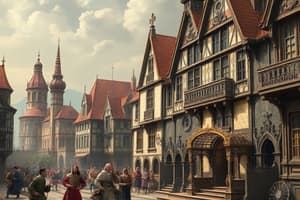Podcast
Questions and Answers
What event led to the remaking of the map of Europe in the 20th century?
What event led to the remaking of the map of Europe in the 20th century?
- The Protestant Reformation
- The Age of Exploration
- The Industrial Revolution
- World War I (correct)
What event led to the creation of the European Union?
What event led to the creation of the European Union?
- The Protestant Reformation
- The Age of Exploration
- The gradual development of the European integration process (correct)
- The Fall of the Berlin Wall
What event led to the division of Europe during the Cold War?
What event led to the division of Europe during the Cold War?
- The Holocaust
- The Iron Curtain (correct)
- Decolonization
- The Industrial Revolution
Flashcards are hidden until you start studying
Study Notes
- The Protestant Reformation saw the fragmentation of religious thought, leading to religious wars.
- The Age of Exploration led to colonization, and the exploitation of the people and resources of colonies brought resources and wealth to Europe.
- After 1800, the Industrial Revolution brought capital accumulation and rapid urbanization to Western Europe, while several countries transitioned away from absolutist rule to parliamentary regimes.
- The Age of Revolutions saw long-established political systems upset and turned over. In the 20th century, World War I led to a remaking of the map of Europe as the large Empires were broken up into nation-states.
- Lingering political issues would lead to World War II, during which Nazi Germany perpetrated the Holocaust.
- After World War II, during the Cold War, most of Europe became divided by the Iron Curtain in two military blocs: NATO and the Warsaw Pact.
- The post-war period saw decolonization as Western European colonial empires were dismantled.
- The post-war period also featured the gradual development of the European integration process, which led to the creation of the European Union; this extended to Eastern European countries after the Fall of the Berlin Wall.
The key facts from the text above are as follows:
- The Protestant Reformation saw the fragmentation of religious thought, leading to religious wars.
- The Age of Exploration led to colonization, and the exploitation of the people and resources of colonies brought resources and wealth to Europe.
- After 1800, the Industrial Revolution brought capital accumulation and rapid urbanization to Western Europe, while several countries transitioned away from absolutist rule to parliamentary regimes.
- The Age of Revolutions saw long-established political systems upset and turned over. In the 20th century, World War I led to a remaking of the map of Europe as the large Empires were broken up into nation-states.
- Lingering political issues would lead to World War II, during which Nazi Germany perpetrated the Holocaust.
- After World War II, during the Cold War, most of Europe became divided by the Iron Curtain in two military blocs: NATO and the Warsaw Pact.
- The post-war period saw decolonization as Western European colonial empires were dismantled.
- The post-war period also featured the gradual development of the European integration process, which led to the creation of the European Union; this extended to Eastern European countries after the Fall of the Berlin Wall.
Studying That Suits You
Use AI to generate personalized quizzes and flashcards to suit your learning preferences.




